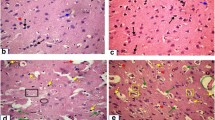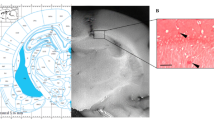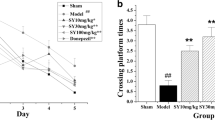Abstract
Numerous evidences have shown that the antioxidative properties of soy isoflavone (SIF) have beneficial effects on prophylaxis of neurodegeneration, however, the mechanism is still not fully illustrated. As cerebrovascular dysfunction could initiate a cascade of events leading to pathogenesis of Alzheimer’s disease, we tried to investigate whether SIF could protect the cerebrovascular system due to antagonizing oxidative damage induced by Aβ1–42 in present study. In addition, NF-E2-related factor 2 (Nrf2) signaling pathways in the cerebrovascular tissue of Wistar rats were investigated to identify the potential cerebrovascular protective targets of SIF. Research results showed that SIF reduced the excessive production of nitrotyrosine in cerebrovascular tissue induced by Aβ1–42, and maintained redox homeostasis by increasing the level of GSH and GSH/GSSG. Moreover, SIF could alleviate the down-regulation of Nrf2, γ-glutamylcysteine synthetase, Heme oxygenase-1 expressions in cerebrovascular tissue induced by Aβ1–42 and suppress the increase of Kelch like ECH protein-1 (Keap1). These data suggested that SIF might reduce the cerebrovascular oxidative damage induced by Aβ1–42 through regulating the Nrf2 signaling pathway. The mechanisms of SIF modulating the potential target Nrf2 might be associated with Keap1 expression.







Similar content being viewed by others
Abbreviations
- Aβ:
-
β-Amyloid peptides
- AD:
-
Alzheimer’s disease
- Nrf2:
-
Transcription factor NF-E2-related factor2
- Keap1:
-
Kelch like ECH protein-1
- γ-GCS:
-
γ-Glutamylcysteine synthetase
- HO-1:
-
Heme oxygenase-1
- GSH/GSSG:
-
Reduced glutathione/oxidized glutathione
References
Stuart B, Melissa MG, Sarah A (2009) Oxidative stress in vascular dementia and Alzheimer’s Disease: a common pathology. J Alzheimers Dis 17:245–257
Lum H, Roebuck KA (2001) Oxidant stress and endothelial cell dysfunction. Am J Physiol Cell Physiol 280:C719–C741
Mercedes B, Joseph SW, Elazer RE (2008) Amyloid beta toxicity dependent upon endothelial cell state. Neurosci Lett 441:319–322
Zlokovic BV (2005) Neurovascular mechanisms of Alzheimer’s neurodegeneration. Trends Neurosci 28:202–208
Tong XK, Nicolakakis N, Fernandes P, Ongali B, Brouillette J, Quirion R, Hamel E (2009) Simvastatin improves cerebrovascular function and counters soluble amyloid-beta, inflammation and oxidative stress in aged APP mice. Neurobiol Dis 35:406–414
Zhu X, Smith MA, Honda K et al (2007) Vascular oxidative stress in Alzheimer disease. J Neurol Sci 257:240–246
Xi YD, Yu HL, Ding J, Ma WW, Yuan LH, Feng JF, Xiao YX, Xiao R (2012) Flavonoids protect cerebrovascular endothelial cells through Nrf2 and PI3K from β-amyloid peptide-induced oxidative damage. Curr Neurovasc Res 9(1):32–41
Valles SL, Dolz-Gaiton P, Gambini J (2010) Estradiol or genistein prevent Alzheimer’s disease-associated inflammation correlating with an increase PPARγ expression in cultured astrocytes. Brain Res 1312:138–144
Xi YD, Li XY, Ding J et al (2013) Soy isoflavone alleviates Aβ1-42-induced impairment of learning and memory ability through the regulation of RAGE/LRP-1 in neuronal and vascular tissue. Curr Neurovasc Res 10(2):144–156
Xi YD, Yu HL, Ma WW et al (2011) Genistein inhibits mitochondrial-targeted oxidative damage induced by beta-amyloid peptide 25-35 in PC12 cells. J Bioenerg Biomembr 43(4):399–407
Yuan LH, Xin Z, Dan L et al (2012) Pattern recognition receptors involved in the inflammatory attenuating effects of soybean isoflavone in β-amyloid peptides 1–42 treated rats. Neurosci Lett 506:266–270
Ma WW, Xiang L, Yu HL et al (2010) Genistein as a neuroprotective antioxidant attenuates redox imbalance induced by β-amyloid peptides 25–35 in PC12 cells. Int J Dev Neurosci 28:289–295
Ding J, Yu HL, Ma WW et al (2013) Soy isoflavone attenuates brain mitochondrial oxidative stress induced by beta-amyloid peptides 1–42 injection in lateral cerebral ventricle. J Neurosci Res 91(4):562–567
Ma WW, Hou CC, Zhou X et al (2013) Genistein alleviates the mitochondria-targeted DNA damage induced by β-amyloid peptides 25–35 in C6 glioma cells. Neurochem Res 38(7):1315–1323
Feng JF, He LL, Li D et al (2012) Antagonizing effects of soybean isoflavones on β-amyloid peptides-induced oxidative damage in neuron mitochondria of rats. Basic Clin Pharmacol Toxicol 111(4):248–253
Ding BJ, Ma WW, He LL, Zhou X, Yuan LH, Yu HL, Feng JF, Xiao R (2011) Soybean isoflavone alleviates β-amyloid 1–42 induced inflammatory response to improve learning and me moryability by down regulation of Toll-like receptor 4 expression and nuclear factor-κB activity in rats. Int J Dev Neurosci 29(5):537–542
Santos MA, Florencio-Silva R, Medeiros VP, Nader HB, Nonaka KO, Sasso GR, Simões MJ, Reginato RD (2013) Effects of different doses of soy isoflavones on bone tissue of ovariectomized rats. Climacteric. doi:10.3109/13697137.2013.830606
Luth HJ, Munch G, Arendt T (2002) Aberrant expression of NOS isoforms in Alzheimer’s disease is structurally related to nitrotyrosine formation. Brain Res 953:135–143
Luth HJ, Holzer M, Gartner U, Staufenbiel M, Arendt T (2001) Expression of endothelial and inducible NOS-isoforms is increased in Alzheimer’s disease, in APP23 transgenic mice and after experimental brain lesion in rat: evidence for an induction by amyloid pathology. Brain Res 913:57–67
He X, Kan H, Cai L, Ma Q (2009) Nrf2 is critical in defense against high glucose induced oxidative damage in cardiomyocytes. J Mol Cell Cardiol 46:47–58
Anwar AA, Li FY, Leake DS, Ishii T, Mann GE, Siow RC (2005) Induction of hemeoxygenase 1 by moderately oxidized low-density lipoproteins in human vascular smooth muscle cells: role of mitogen-activated protein kinases and Nrf2. Free Radic Bio1 Med 39:227–236
Gozzelino R, Jeney V, Soares MP (2010) Mechanisms of cell protection by hemeoxygenase-1. Annu Rev Pharmacol Toxicol 50:323–354
Johnson JA, Johnson DA, Kraft AD et al (2008) The Nrf2-ARE pathway: an indicator and modulator of oxidative stress in neuro degeneration. Ann N Y Acad Sci 1147:61–69
Acknowledgments
The authors appreciate the financial support provided by National Natural Science Foundation of China (No. 81172661 and 81302427), the National High Technology Research and Development Program (863 Program) of China (No. 2010AA023003).
Conflict of interest
The authors declare that there are no conflicts of interest.
Author information
Authors and Affiliations
Corresponding author
Additional information
Yuan-Di Xi and Xiao-Ying Li have contributed equally to this work.
Rights and permissions
About this article
Cite this article
Xi, YD., Li, XY., Yu, HL. et al. Soy Isoflavone Antagonizes the Oxidative Cerebrovascular Injury Induced by β-Amyloid Peptides 1–42 in Rats. Neurochem Res 39, 1374–1381 (2014). https://doi.org/10.1007/s11064-014-1319-x
Received:
Revised:
Accepted:
Published:
Issue Date:
DOI: https://doi.org/10.1007/s11064-014-1319-x




